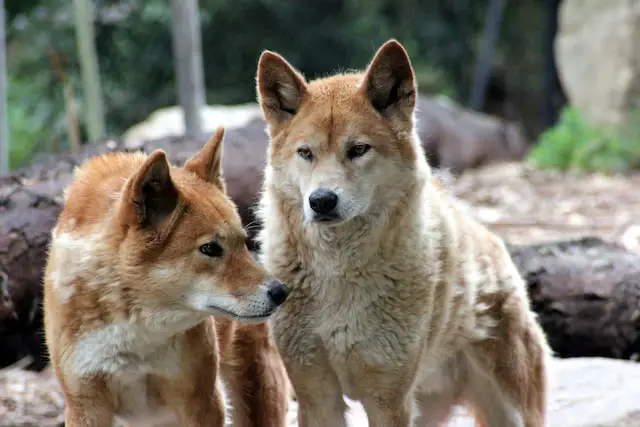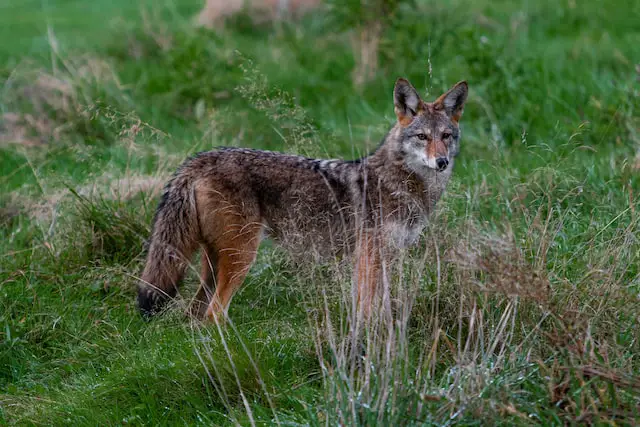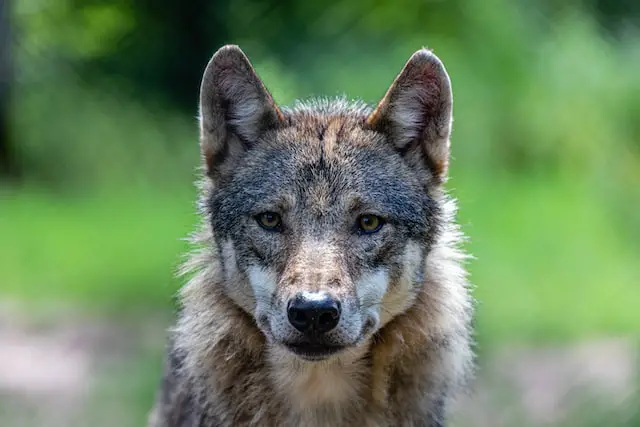Dingoes are wild dogs native to Australia, while coyotes are native to North America. Dingoes have heavier build, broader snouts and shorter fur, whereas coyotes have a more slender build and a more pointed snout and longer fur.
What is a dingo?
(Photo by Craig Manners on Unsplash )

A dingo is a wild dog found in Australia. Dingoes are thought to be descended from domesticated dogs that were brought to Australia by humans thousands of years ago. They are similar in appearance to other types of wild dogs, such as coyotes, but dingoes have longer legs and softer fur.
Dingoes typically live in packs of six to ten individuals, although packs of up to thirty have been observed. The dingo is an apex predator, meaning it is at the top of the food chain and has no natural predators in Australia. However, they are persecuted by humans because they are considered a pest species.
What is a coyote?
(Photo by Dylan Ferreira on Unsplash )

Coyotes are members of the canine family and look similar to medium-sized dogs. They are often referred to as “prairie wolves” and are found throughout North and Central America. Coyotes typically weigh between 20 and 50 pounds, but can grow up to 100 pounds. They have long snouts, bushy tails, and large ears. Coyotes range in color from gray to blond, but most are a brownish-gray color.
Coyotes are intelligent animals and are known for their cunning abilities. They are very versatile and adaptable, which has helped them thrive in many different ecosystems. Coyotes live in packs of 6 to 10 individuals, but will sometimes associate with other coyote groups or even with wolves. The average lifespan of a coyote is about 6 to 8 years, but some individuals have been known to live up to 15 years in captivity.
Coyotes are omnivorous animals and will eat just about anything they can find. Their diet consists of small mammals, fruits, vegetables, carrion, and even garbage. Coyotes will also prey on larger animals such as deer or elk if the opportunity presents itself. In recent years, there has been an increase in the number of coyotes attacking humans. This is likely due to the loss of their natural habitat and increased contact with humans as a result of urbanization.
How do dingo and coyote look different?
Dingoes and coyotes both have a similar overall appearance, but there are some key differences between them. For one, dingoes are generally larger than coyotes, with males averaging about 30 inches in length from nose to tail and females averaging about 27 inches. Coyotes, on the other hand, typically range from 24 to 37 inches in length. Additionally, dingoes tend to have longer legs and narrower snouts than coyotes. Their fur also tends to be coarser and more reddish in color, while coyote fur is usually more grayish-brown. Finally, dingoes typically live only in Australia, while coyotes can be found throughout North and Central America.
Behavioral Differences between Dingoes and Coyotes
Dingoes are known for their distinctive howl, which is often described as a mournful or haunting sound. They are solitary animals that live in small family groups and are primarily active at night. Dingoes hunt a variety of prey, including kangaroos, wallabies, and small mammals.
Coyotes, on the other hand, are more social animals that live in larger packs. They are highly adaptable and opportunistic feeders, and will eat almost anything they can find, including small mammals, birds, reptiles, and even fruit and vegetables. Unlike dingoes, coyotes are active both during the day and night and are known for their high-pitched howls, which are often heard in rural areas.
Hybridization between Dingoes and Coyotes
One of the most significant differences between dingoes and coyotes is that they can interbreed and produce viable offspring. This hybridization is a result of the overlap of their ranges in areas such as the American Southwest and Mexico. Hybridization between dingoes and coyotes is a concern for conservationists, as it can lead to the loss of the pure dingo gene pool and the unique characteristics that make them a distinct species.
What is the difference in habitat between dingo and coyote?
Dingoes are primarily found in Australia, although some populations have been introduced to other parts of the world. They live in a variety of habitats, including deserts, grasslands, and forests. Coyotes, on the other hand, are native to North America but have expanded their range to Central America and even some parts of North Africa. They are highly adaptable and can live in a wide range of habitats, from deserts to forests to suburban areas.
What do dingo and coyote eat?
Dingoes and coyotes both eat a variety of meats, but their preferred prey depends on their location. In Australia, dingoes hunt kangaroos, wallabies, and rabbits, while in North America, coyotes primarily target small rodents like mice and ground squirrels. Both predators will also eat fruit, vegetables, and carrion when available.
Conservation Status of Dingoes and Coyotes
The conservation status of dingoes and coyotes vary. Dingoes are considered to be a threatened species in Australia due to habitat loss, interbreeding with domestic dogs, and government-led extermination programs. Despite this, they are not currently listed as an endangered species under Australian law.
Coyotes, on the other hand, are considered to be a species of least concern by the International Union for Conservation of Nature (IUCN). This is due to their wide range and adaptability, as well as their ability to thrive in both rural and urban environments. Although they are hunted for sport and to protect livestock in some areas, their populations remain stable overall.
Are dingo and coyote dangerous to humans?
Both dingoes and coyotes can pose a threat to humans under certain circumstances. Dingoes, like all wild animals, can act aggressively if they feel threatened or cornered. Attacks on humans are relatively rare but have been known to occur, particularly in areas where dingoes have become habituated to human presence.
Coyotes, while generally shy and wary of humans, have been known to attack people, especially children, in rare cases. This is often due to the coyotes losing their natural fear of humans, which can occur when they become habituated to human presence or when they are attracted by accessible food sources, such as pet food or garbage. However, the likelihood of a coyote attacking a human is still low, and most encounters with coyotes result in the coyote running away.
What dog breed is a dingo?
The dingo is not a breed of domestic dog, but rather a distinct species of wild dog (Canis dingo) native to Australia. The dingo is believed to have originated from Asian wolves that were brought to Australia by human migrants thousands of years ago. Over time, the dingoes in Australia evolved into a distinct population that is now recognized as a separate species. While dingoes are sometimes kept as pets, they are not typically bred with other domestic dogs, and are considered to be a unique species in their own right.
What is the closest animal to a dingo?
The dingo is the largest and most well-known member of the canid family in Australia. The closest relative to the dingo is the coyote, which is found in North America. Both species are members of the subfamily Caninae, which includes all dogs, wolves, foxes, and jackals.
Can dingo be a pet?
Yes, dingo can be a pet. In fact, dingoes are often bred and sold as pets. However, it is important to remember that dingoes are wild animals and not domesticated like dogs. This means that they may not be suited for life in a home environment and may become aggressive or destructive if not properly cared for.
Is a dingo stronger than a wolf?
Wolves are the largest members of the canine family, with males averaging between 130 and 175 pounds. Females are typically smaller, between 110 and 140 pounds. Dingoes are a bit smaller than wolves, averaging between 50 and 70 pounds for males and 40 to 60 pounds for females. So, when it comes to sheer size and brute strength, the wolf has the dingo beat.
But size isn’t everything. When it comes to survival in the wild, dingoes have a few advantages over wolves. For one thing, they’re better adapted to Australia’s harsh climate and rugged terrain. They’re also more resistant to disease, which means they often outlive their canine cousins in the wild.
In terms of hunting ability, both wolves and dingoes are top-notch predators. But here again, the dingo has a few tricks up its sleeve. Thanks to its quick reflexes and sharp teeth, the dingo is able to take down prey that would be too much for a wolf to handle alone. And because they hunt in packs, dingoes are often able to bring down larger prey than a single wolf could take on by itself.
Can coyotes breed with dogs?
Yes, coyotes and dogs can breed with each other and produce fertile offspring. In fact, coyotes are often referred to as “wild dogs” because of their close genetic relationship to dogs. Coyotes typically have a more pointed snout and ears than dogs, and they are generally smaller in size. However, there is a lot of variation in the appearance of both coyotes and dogs, so it is not always easy to tell them apart.
Why don t dingoes bark?
Dingoes do not bark as frequently as domestic dogs. Instead, they communicate using a variety of vocalizations, including growls, whines, and howls. The exact reason for this difference is not known, but it is believed to be due to evolutionary differences between dingoes and domestic dogs. Domestic dogs have been selectively bred for thousands of years for various traits, including barking, which is useful for communicating with their human owners. Dingoes, on the other hand, have evolved in the wild and have not been subjected to the same level of selective breeding. As a result, they have retained a more limited range of vocalizations that are better suited to their needs as wild animals.
What type of animal is a coyote?
The coyote is a member of the Canidae family and is closely related to the domestic dog. Coyotes are native to North America and can be found from Alaska all the way down to Central America.
While coyotes vary in size depending on their geographical location, they typically weigh between 20 and 50 pounds. They have a slim build with long legs, and their fur can be various shades of brown or grey. Perhaps the most distinguishing feature of the coyote is their bushy tail, which is often darker than the rest of their coat.
Coyotes are highly intelligent animals and are known for their cunning. They are proficient hunters and often work together in packs to take down prey. Their diet consists mostly of small mammals such as rodents or rabbits, but they will also eat birds, reptiles, fish, fruits, and vegetables.
While coyotes generally avoid humans, they are not afraid to take advantage of an easy meal. This has led to conflicts with people in some areas, as coyotes will raid garbage cans or pet food bowls left out overnight. In recent years, there has been an increase in reports of coyotes attacking people, although these incidents are still rare.
Do coyotes go for humans?
Coyotes are typically shy around humans and will only attack if they feel threatened. If a coyote does attack, it is usually in response to someone acting aggressively towards them or their territory. In general, coyotes are not interested in attacking humans and will only do so if they feel threatened or if there is food involved.
Should I be scared of coyotes?
As top predators, coyotes usually steer clear of humans, but there have been recent reports of coyotes attacking people. In general, you should not be scared of coyotes unless you are actively harassing or threatening them. If you see a coyote, make yourself as big and loud as possible to scare it off.
Can a coyotes be a pet?
Yes, coyotes can be pets, but they are not as common as dogs or cats. Coyotes are wild animals and their behavior is not always predictable. They can be aggressive, and even dangerous, to humans and other animals. If you’re considering making a coyote your pet, be sure to do your research first and consult with a professional.
Why do coyotes cry at night?
Coyotes often howl at night as a way of communicating with other members of their pack. Howling helps coyotes to locate each other, especially when hunting or traveling in large territories. It is also used to establish and reinforce social bonds within the pack, and to warn other coyotes of potential threats, such as intruders from other packs. The high-pitched, mournful sound of a coyote howl can carry for several miles, making it an effective way for coyotes to communicate over long distances. Additionally, the howling of coyotes is often used to mark the boundaries of their territory, helping to deter other coyotes from encroaching.
Featured Image By – Photo by Mario Losereit on Unsplash









